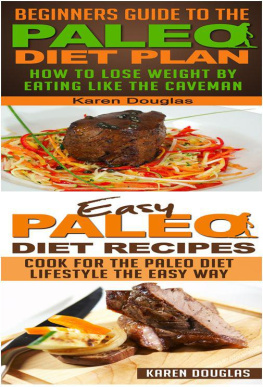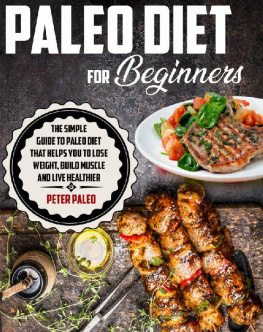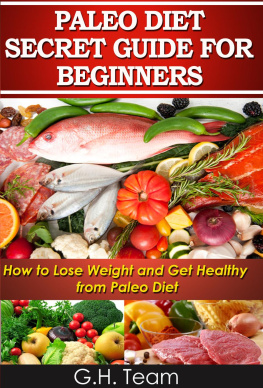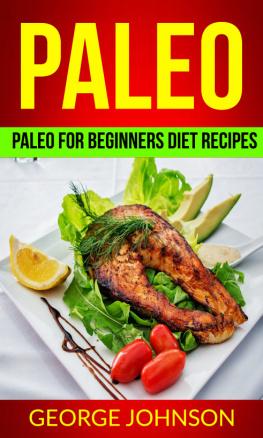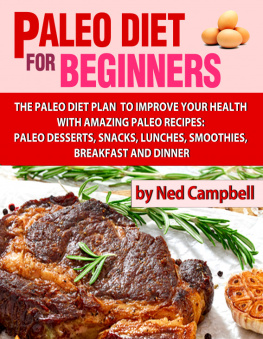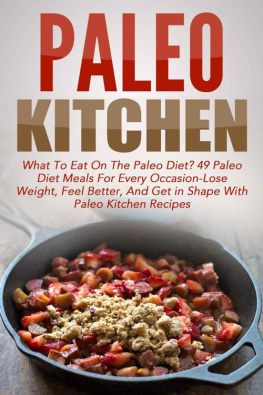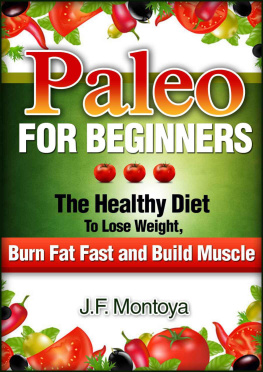TWO BOOK BUNDLE
BEGINNERS GUIDE TO THE PALEO DIET PLAN
AND
EASY PALEO DIET RECIPES COOKBOOK
BY
KAREN DOUGLAS
Copyright 2013 by Karen Douglas
All rights reserved.
This book is protected under the copyright laws of the United States of America. No part of this work may be used, reproduced, or transmitted in any form or by any means, electronic or mechanical, including photocopying, recording and faxing, or by any information storage and retrieval system by anyone but the purchaser for their own personal use.
This Book may not be reproduced in any form without the express written permission of Karen Douglas, except in the case of a reviewer who wishes to quote brief passages for the sake of a review written for inclusions in a magazine, newspaper, or journaland these cases require written approval from Karen Douglas prior to publication. Any reproduction or other unauthorized use of the material or artwork herein is prohibited without the express written permission of the author.
This book is not intended as a substitute for the medical advice of physicians. The reader should regularly consult a physician in matters relating to his/her health and particularly with respect to any symptoms that may require diagnosis or medical attention.
TABLE OF CONTENTS

PREFACE
It has often been said that change is progress and in the eyes of many people, change is always for the better. While technological advances and new medical discoveries have shaped modern society, not all of the changes that have occurred over the past several thousand years have been good. Whereas humans used to live simple lives, todays culture is burdened by the desire to own the next big thing or to hop on board with the latest fashion trend. The desire to improve has become a compulsion, a driving need for some people to the point that they are willing to do anything to get it.
This obsessive desire for improvement has spilled over into the realm of health and fitness, especially in Western cultures. Fad diets are sweeping the nation and millions of people are making drastic changes to their diets and exercise routines for the sake of achieving the perfect figure. While many see results while following crash diets or exercising obsessively, few realize that though they may have achieved the look they desire, they have not actually become any healthier in many cases, these diets can actually be detrimental to ones health. In cultures dominated by processed foods and diet products, wholesome nutrition often seems hard to come by and many people do not even realize that it is missing from their diets.
Looking back to a simpler time, early humans living during the Paleolithic Era were hunters and gatherers everything they ate came directly from the earth, procured by their own two hands. Agriculture has only existed for the past ten thousand years or so and the type of agriculture responsible for the production of refined sugars and enriched flours has only existed for about two hundred years. Today it is too easy to simply pull up to the local drive-in, order a burger with fries and call it a meal. Whereas Paleolithic humans dedicated much of their time to hunting and gathering food, people today rarely have to travel more than a few blocks to find something to eat. In fact, it is possible to construct a diet based on fast food alone without ever setting foot into a grocery store or preparing a meal by hand.
Unfortunately, many people choose to adopt this kind of lifestyle and, perhaps as a result, risk factors for serious health conditions have skyrocketed in recent years. In a health survey conducted in 2010, the U.S. Department of Health and Human Services determined that 9% of adults over the age of 18 had been diagnosed with diabetes and 12% were told that they had heart disease. The results of the survey also indicated that 34% of adults over the age of 18 were overweight and 28% were obese. In addition to these health-related findings, the survey also indicated that 53% or adults labeled themselves either inactive or insufficiently active in terms of aerobic activity.
The results of this 2010 health survey indicate that significant changes have occurred since the Paleolithic Era, not only in terms of technology and agriculture, but also in human lifestyles. The availability of food is taken for granted by many and because it is no longer necessary to expend much physical effort to obtain food and other resources, many people make very little effort to stay active. Both of these factors have combined to result in a significant decline in overall health in modern Western cultures as well as a decreased average lifespan and an increased risk for chronic illness.
Though human diets and lifestyles have changed significantly over the past fifteen thousand years, one thing has remained largely unchanged: human genetics. Scientific studies have revealed that the modern human genome is 99.9% equivalent to the human genome from the Paleolithic Era. With this evidence in mind, the dietary changes that have come about over the past several thousand years have not been out of necessity the human body is still capable of subsisting on the same type of diet Paleolithic Era humans followed. This is the founding principle of the Paleolithic Diet.
Also referred to as the Caveman Diet or simply shortened to the Paleo Diet, this diet is based on evolutionary science and it is meant to include only those foods which would have been available to Paleolithic Era humans. While the Paleo Diet may seem like a drastic dietary change or just another fad diet to some, it is actually a healthy lifestyle change that may have numerous health benefits. By purging your body of the chemicals and toxins introduced by processed foods and hormone-laced protein sources, your body will be able to achieve the level of health and function that it was meant to achieve.
CHAPTER 1: SCIENCE BEHIND THE PALEO DIET

The Paleo Diet is based on the fact that the human genetic code has not evolved significantly during the past ten to fifteen thousand years. This being the case, our bodies are still designed to thrive on the same diet they adapted to during the Paleolithic Era, specifically whole foods like fresh fruits, vegetables and wild game. The human bodys response to food has not changed it still digests food in the same way and we still have the same nutritional requirements. What has changed, however, is the type of food we eat.
Although Paleolithic Era humans were unable to rely on processing (and sometimes even cooking) their food, many modern diets are the product of developments in agriculture. Foods like grains including wheat and rice, as well as beans and potatoes, are inedible in a raw state and thus were not part of the Paleolithic Era diet. With the dawn of agriculture, cooking and farming methods made it possible to eat and store these foods. As a result, the number of edible foods available to man increased and many of these new foods displaced the staples of the Paleolithic Era diet.
It is well-known that Paleolithic Era humans were smaller, leaner and many believe lived longer than modern humans. There are many factors which can be attributed to this observation, but diet is one of the main factors. Prior to the development of agriculture, Paleolithic Era humans only had access to foods that could be consumed raw or with little cooking. These foods included vegetables, fruits, seeds, roots, fish, fowl and wild game. Foods like grains, beans and potatoes could not be consumed raw because they contain toxins that make humans sick upon consumption. With the discovery of modern cooking methods and agricultural developments, however, it eventually became possible to consume these foods safely.
Next page
